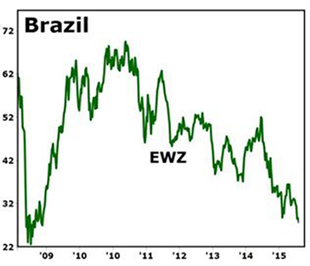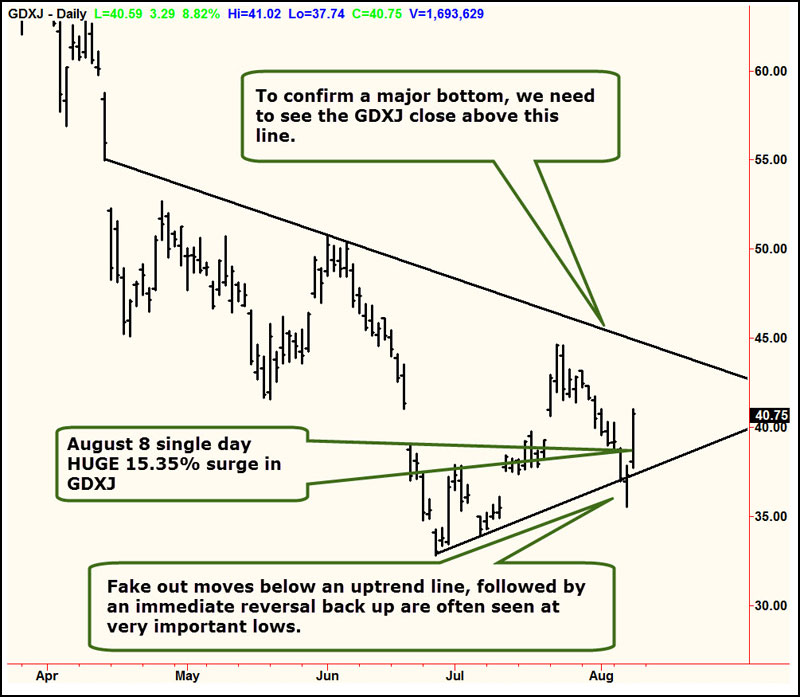
For many moons, Larry Edelson, Mike Larson and I have been alerting you to a series of upcoming disruptions and dangers overseas — wars, revolutions, recession, and chaos.
We told you they would spread; and they have.
We predicted they would drive wave after wave of flight capital to our shores, and they have.
Plus, we pinpointed the most obvious, most immediate, victims of those disasters — investors who plowed their money into emerging market countries. And now, those investors are getting killed in a series of disastrous stock declines:
 Brazil has suddenly flip-flopped from a miracle economy to a basket case.
Brazil has suddenly flip-flopped from a miracle economy to a basket case.
Brazil’s service sector, once robust, has just suffered its largest fall since early 2009.
Overall economic activity is falling at an estimated annual rate of almost 5%.
The Brazilian currency — the real — has lost half its value.
And a massive corruption scandal, which began with Brazil’s oil giant Petrobras, has now spread fear to the boardrooms of dozens of the country’s largest corporations.
Result: EWZ, the once-high-flying ETF that represents Brazil’s largest companies, has suffered a long-term plunge from over 99 to a recent low of 27 — a wipe-out decline of almost 72%.
Moreover, it is now approaching the extreme low it made back in the depth of the 2008 bear market.
If that level is broken, look out below!
South Korea, recently a darling of global investors, has suddenly been cast as one of the dogs.
Youth unemployment has crept up to record highs.
 The working-age population, which, until recently had made South Korea an export powerhouse, is shrinking.
The working-age population, which, until recently had made South Korea an export powerhouse, is shrinking.
And among Korea’s elderly, poverty is the worst of all 34 countries that belong to the Organization for Economic Cooperation and Development (OECD).
For all these reasons — and more — EWY, the ETF specialized in South Korea’s blue chips, took a beating in 2014, rallied, and has now taken an even bigger beating in 2015.
Malaysia, another recent “miracle” economy, has been hit even harder:
Its currency, the ringgit, has crashed to its lows of the late 1990s.
Its central bank, desperate to prevent an even more dramatic currency crash, is depleting its foreign currency reserves.
 Adding corruption to the mix, the government’s giant investment fund — 1MDB — is under investigation over allegations of a massive misappropriation.
Adding corruption to the mix, the government’s giant investment fund — 1MDB — is under investigation over allegations of a massive misappropriation.
The biggest blow of all: The global oil-price plunge, gutting Malaysia’s largest source of revenues.
So it’s no wonder that the ETF devoted to Malaysia’s leading stocks has also been smacked down, busting through four years of lows.
But it’s Russia that currently worries me the most — both for the sake of its own people and the rest of the world.
If Russia’s economic swan dive could be blamed exclusively on its showdown with the West — sanctions, countersanctions and now more sanctions — you could argue that, once politicians on both sides come to their senses, a big rally might be in the offing.
Alternatively, if you could pin it all on the oil-price slump, you might argue that, as soon as oil markets turn, all would be fine.
The reality, however, is that Russia is being dragged down by both of these simultaneously. And both are entrenched megatrends with no signs of ending: The anti-West propaganda machine in Russia is now fully entrenched and empowered, making it almost impossible politically for the leadership to reverse course. And even if oil markets started recovering today, it could take years for Russia to recoup lost revenues.
Bottom-line: Russia is trapped in a Great Recession that’s probably going to be a lot bigger than what the U.S. has seen in recent years. They’re looking at …
* GDP set to shrink by 3.4% this year and by as much as 9% overall
* A ruble that sank by half last year, and is now sinking again.
 * Plus a great bear market in Russia’s leading stocks, which, even in the absence of an East-West conflict, would frighten away the most cold-blooded global investor.
* Plus a great bear market in Russia’s leading stocks, which, even in the absence of an East-West conflict, would frighten away the most cold-blooded global investor.
Like Brazil’s stock market, it’s not too far from the prior Big Bottom made in early 2009.
And like Brazil’s, if that critical low is breached, a further collapse could be hard to avoid.
The big question …
What does this mean for U.S. investors?
Are these foreign markets strictly victims of the global flight to quality — hitting their stocks hard, but giving ours a boost?
Or are they early storm warnings of similar tempests that could ultimately reach the United States too?
We believe that, for now at least, it’s mostly the former. But it’s not too soon to start waving a yellow flag of caution.
So if you haven’t done so already, be sure to …
 Own only the highest-quality stocks in the strongest U.S. sectors …
Own only the highest-quality stocks in the strongest U.S. sectors …
 Keep a super-sized portion of your money in cash, and
Keep a super-sized portion of your money in cash, and
 Get ready to take even more protective action if needed.
Get ready to take even more protective action if needed.
Good luck and God bless!
Martin












